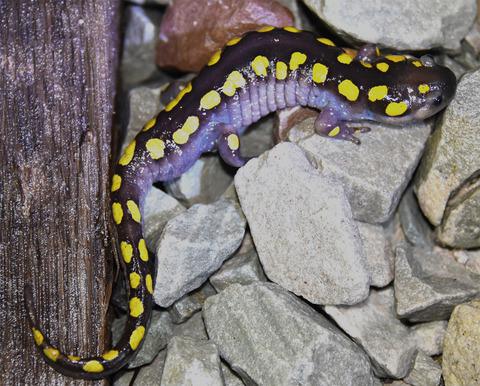当前位置:
X-MOL 学术
›
Anim. Conserv.
›
论文详情
Our official English website, www.x-mol.net, welcomes your feedback! (Note: you will need to create a separate account there.)
Skin defenses of North American salamanders against a deadly salamander fungus
Animal Conservation ( IF 3.4 ) Pub Date : 2021-01-11 , DOI: 10.1111/acv.12666 K. E. Pereira 1 , S. K. Woodley 1
Animal Conservation ( IF 3.4 ) Pub Date : 2021-01-11 , DOI: 10.1111/acv.12666 K. E. Pereira 1 , S. K. Woodley 1
Affiliation

|
The recently emerged fungal pathogen, Batrachochytrium salamandrivorans (Bsal) causes the lethal skin disease chytridiomycosis in susceptible salamander species and is predicted to emerge within the Americas with devastating consequences. Host responses to Bsal are variable but the factors underlying these differences are unknown. To investigate the role of skin-associated immune defenses against Bsal and the closely related, B. dendrobatidis (Bd), we sampled skin peptides from wild and captive North American salamanders (spotted salamanders [Ambystoma maculatum], n = 10; hellbenders [Cryptobranchus alleganiensis], n = 2; red-legged salamanders [Plethodon shermani], n = 18; and Ocoee salamanders [Desmognathus ocoee], n = 15) and conducted in vitro experimental assays to test whether salamander skin peptides inhibit chytrid growth. Interspecies differences in skin defenses against Bsal and Bd, and peptide mixtures were also assessed using a standardized measure and RP-HPLC, respectively. For A. maculatum, skin peptides inhibited Bsal and Bd growth, consistent with known Bsal resistance. Cryptobranchus alleganiensis skin peptides inhibited the growth of Bsal but not Bd. Plethodon shermani and D. ocoee skin peptides facilitated Bsal growth and had either no effect or inconsistent effects on Bd growth. With the exception of A. maculatum, most species had relatively weak skin defenses against both chytrid pathogens. Collectively, we demonstrate that salamander skin peptide defenses against chytrid pathogens are highly variable and not always equally effective against Bsal and Bd. By advancing knowledge about the factors underlying chytrid susceptibility, particularly Bsal, our findings will help inform conservation initiatives aimed at reducing disease impacts and biodiversity loss.
中文翻译:

北美蝾螈对致命蝾螈真菌的皮肤防御
最近出现的真菌病原体Batrachochytrium salamandrivorans ( Bsal ) 在易感的蝾螈物种中引起致命的皮肤病壶菌病,预计将在美洲出现,带来毁灭性的后果。宿主对Bsal 的反应是可变的,但这些差异背后的因素尚不清楚。为了研究皮肤相关免疫防御对Bsal和密切相关的B. dendrobatidis ( Bd ) 的作用,我们从野生和圈养的北美蝾螈(斑点蝾 [ Ambystoma maculatum ],n = 10;地狱弯曲者 [ Cryptobranchus胡桃], n = 2; 红腿蝾螈 [ Plethodon shermani ], n = 18 ; 和 Ocoee 蝾螈 [ Desmognathus ocoee ],n = 15) 并进行了体外实验测定以测试蝾螈皮肤肽是否抑制壶菌生长。还分别使用标准化测量和 RP-HPLC 评估了针对Bsal和Bd以及肽混合物的皮肤防御的种间差异。对于A. maculatum,皮肤肽抑制Bsal和Bd生长,与已知的Bsal抗性一致。阿勒格尼隐枝鱼皮肽抑制Bsal但不是Bd。Plethodon shermani和D. ocoee皮肤肽促进Bsal生长,并且对Bd生长没有影响或影响不一致。除了A. maculatum 之外,大多数物种对两种壶菌病原体的皮肤防御能力都相对较弱。总的来说,我们证明蝾螈皮肤肽对壶菌病原体的防御是高度可变的,并且对Bsal和Bd并不总是同样有效。通过提高关于壶菌易感性因素的知识,特别是Bsal,我们的发现将有助于为旨在减少疾病影响和生物多样性丧失的保护举措提供信息。
更新日期:2021-01-11
中文翻译:

北美蝾螈对致命蝾螈真菌的皮肤防御
最近出现的真菌病原体Batrachochytrium salamandrivorans ( Bsal ) 在易感的蝾螈物种中引起致命的皮肤病壶菌病,预计将在美洲出现,带来毁灭性的后果。宿主对Bsal 的反应是可变的,但这些差异背后的因素尚不清楚。为了研究皮肤相关免疫防御对Bsal和密切相关的B. dendrobatidis ( Bd ) 的作用,我们从野生和圈养的北美蝾螈(斑点蝾 [ Ambystoma maculatum ],n = 10;地狱弯曲者 [ Cryptobranchus胡桃], n = 2; 红腿蝾螈 [ Plethodon shermani ], n = 18 ; 和 Ocoee 蝾螈 [ Desmognathus ocoee ],n = 15) 并进行了体外实验测定以测试蝾螈皮肤肽是否抑制壶菌生长。还分别使用标准化测量和 RP-HPLC 评估了针对Bsal和Bd以及肽混合物的皮肤防御的种间差异。对于A. maculatum,皮肤肽抑制Bsal和Bd生长,与已知的Bsal抗性一致。阿勒格尼隐枝鱼皮肽抑制Bsal但不是Bd。Plethodon shermani和D. ocoee皮肤肽促进Bsal生长,并且对Bd生长没有影响或影响不一致。除了A. maculatum 之外,大多数物种对两种壶菌病原体的皮肤防御能力都相对较弱。总的来说,我们证明蝾螈皮肤肽对壶菌病原体的防御是高度可变的,并且对Bsal和Bd并不总是同样有效。通过提高关于壶菌易感性因素的知识,特别是Bsal,我们的发现将有助于为旨在减少疾病影响和生物多样性丧失的保护举措提供信息。



























 京公网安备 11010802027423号
京公网安备 11010802027423号